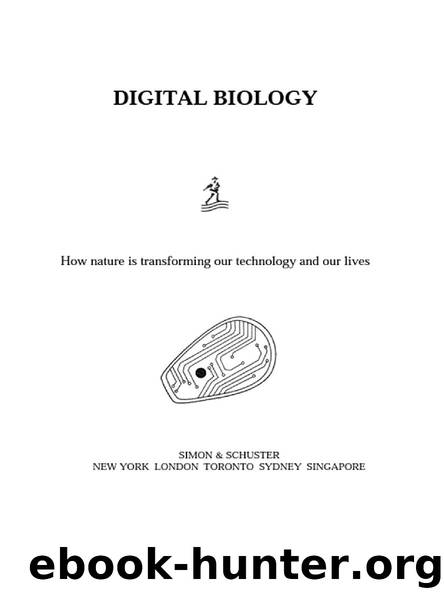Digital Biology by Peter J. Bentley

Author:Peter J. Bentley
Language: eng
Format: epub
Publisher: Simon & Schuster
Published: 2009-07-15T00:00:00+00:00
DIGITAL PATTERNS
We are in a large, dark room, 12 meters long and 6 meters wide. In front of us are five wooden columns, each with a different plant on the top. They are arranged in a semicircle around a large 4 × 3 meter screen. The screen is acting like the mirror in Through the Looking-Glass, showing us another room filled with plants. But time seems to be moving more quickly there. The plants in the other room are visibly growing before our eyes.
You approach one of the plants on its wooden pedestal. As you reach out to touch it, you suddenly notice on the screen that an identical plant is now growing in the other room. You see new stems push upward, leaves form and grow, with foliage pushing through the existing plants toward the light above. As your hands approach the plant, you see the growth in front of you change: the plant grows taller and more angled. You quickly discover that you can change the shape and type of the growing plants on the screen by moving toward and touching the plants in front of you. After some experimentation, you discover that you can make mosses, ferns, vines, and trees grow before your eyes. You also discover that with sufficient hand waving you can introduce a “killer plant” that clears space by removing parts of the lush vegetation before you.
A strange room, indeed. But despite the fun of creating digital plants, this is not just a toy. You are standing at a junction between two universes: physical and digital. The plants in one help create the plants in the other.
At this point you’re probably wondering if I have led you into some make—believe place that I have conjured up out of my imagination. In fact, the room exists exactly as described. It is an exhibition in the ZKM Media Museum in Karlsruhe, Germany. The creation of artists Christa Sommerer and Laurent Mignonneau, this work demonstrates, in one of the most graphic ways possible, how we can grow digital plants that resemble biological ones. Their interactive computer installation uses biological plants as the interface to digital plants. Their computer senses how close your hands are to the plants on the wooden columns and grows digital plants in response. As you move, the computer adjusts the rules of growth, and the digital plants change dynamically.
This is an example of digital plants being used as art, but it is certainly not the only one. Artists have been growing digital forms using growth rules for many years. Jane Prophet, Paul Brown, William Latham, Alan Dorin, Rod Berry, and other artists all use plantlike growth to generate their art, with great international success. Many of them also use evolution to fine-tune the growth rules. They have shown that with the right rules, the resulting forms are as beautiful and original as the patterns in nature.
With the right rules. But what kinds of rules do we need in order to grow digital plants?
Download
This site does not store any files on its server. We only index and link to content provided by other sites. Please contact the content providers to delete copyright contents if any and email us, we'll remove relevant links or contents immediately.
| Biomathematics | Differential Equations |
| Game Theory | Graph Theory |
| Linear Programming | Probability & Statistics |
| Statistics | Stochastic Modeling |
| Vector Analysis |
Weapons of Math Destruction by Cathy O'Neil(5032)
Factfulness: Ten Reasons We're Wrong About the World – and Why Things Are Better Than You Think by Hans Rosling(4016)
Factfulness_Ten Reasons We're Wrong About the World_and Why Things Are Better Than You Think by Hans Rosling(2751)
Descartes' Error by Antonio Damasio(2728)
A Mind For Numbers: How to Excel at Math and Science (Even If You Flunked Algebra) by Barbara Oakley(2688)
TCP IP by Todd Lammle(2633)
Applied Predictive Modeling by Max Kuhn & Kjell Johnson(2475)
Fooled by Randomness: The Hidden Role of Chance in Life and in the Markets by Nassim Nicholas Taleb(2408)
The Book of Numbers by Peter Bentley(2400)
The Tyranny of Metrics by Jerry Z. Muller(2399)
The Great Unknown by Marcus du Sautoy(2180)
Once Upon an Algorithm by Martin Erwig(2143)
Easy Algebra Step-by-Step by Sandra Luna McCune(2111)
Practical Guide To Principal Component Methods in R (Multivariate Analysis Book 2) by Alboukadel Kassambara(2089)
Lady Luck by Kristen Ashley(2067)
Police Exams Prep 2018-2019 by Kaplan Test Prep(2028)
Linear Time-Invariant Systems, Behaviors and Modules by Ulrich Oberst & Martin Scheicher & Ingrid Scheicher(1980)
All Things Reconsidered by Bill Thompson III(1957)
Secrets of Creation, Volume 1: The Mystery of the Prime Numbers by Watkins Matthew(1858)
